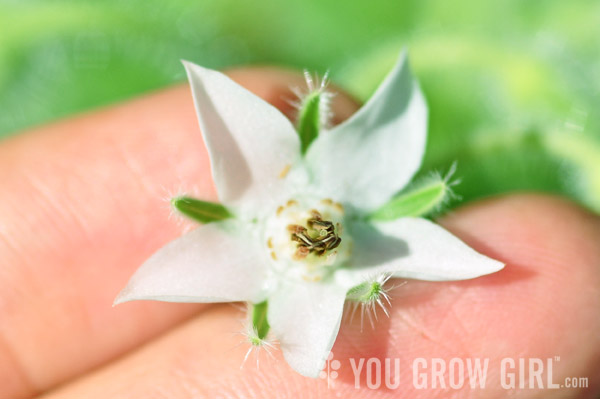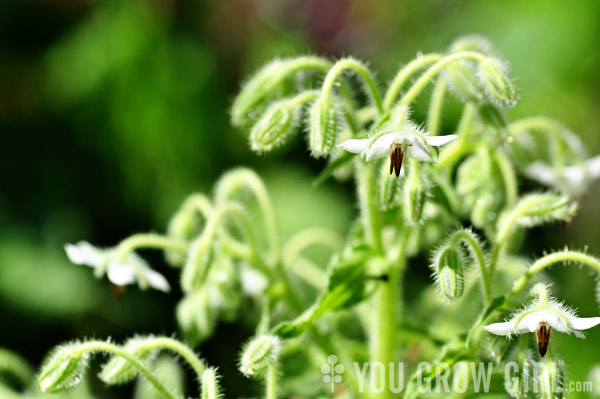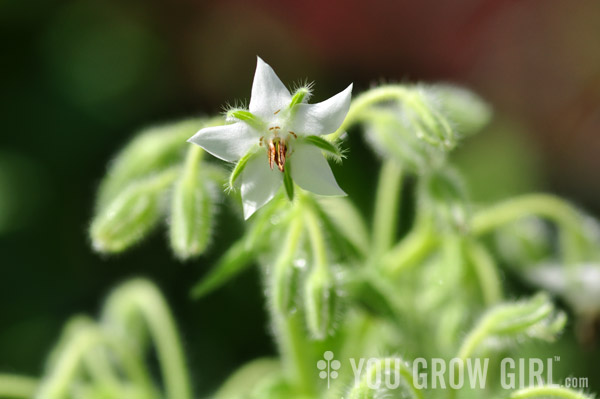
When it comes to borage there is always too much and never enough.
I’ve been growing regular ole blue borage flowers for years; first at my community garden plot and now here in my small urban backyard where they are happy — too happy — growing into monstrous, prickly sea creature-like things that make my arms itch furiously on contact. Every spring I squeal with delight when the seedlings pop their familiar, juicy seed leaves up through the soil. They’re as prolific as the shiso and those blasted morning glories, but I never seem to mind the work of plucking countless borage babies. The seed leaves are soft, hairless, and taste like cucumbers. I wash each morning’s gleanings clean and toss them fresh into the spring’s first homegrown salads. Drunk with sunshine and the anticipation of a new growing season, I always leave too many behind.
By early summer their many limbs tumble and sprawl and become entangled in the tomatoes (borage loves tomatoes). There are too many and they are a nuisance. Now, visits out to the garden end with my arms slathered in a thick application of Aveeno and I beg Davin to clear some of the infernal things away. But not too many. The bees love the little star-like flowers and so do I.

From the moment I heard about white borage I just had to grow it. In my imagination they appeared ethereal, a ghostly flower. Suddenly the little blue flowers simply would not do. In the garden I am forever chasing something new. Something different. I imagined a bed of starry, white flowers, translucent and glistening in the sunlight. A friend gave me some seeds and I scattered them liberally and carelessly. I forgot all about the prickles and the too many seedlings and the daily burning pox that covers my arms. I waited. I forgot where I cast the seeds and was forced to allow too many spring seedlings to grow and thrive, hoping that one would bear the elusive, white flowers. None did.
I tried a second year with the same result.
Then, this spring I was gifted a third packet from a gardener who attended a talk I gave on herbs. A creature of habit and a bad case of winter borne amnesia, I dumped the whole packet and then promptly forgot the location. Borage seedlings appeared on schedule and as before I allowed too many to thrive. I waited. I watched. Blue, blue, blue, blue, blue. All blue.

Finally, in August, months after the first of the season’s borage had come and gone, a few new plants came up in a part of the garden that had been borage free. These plants were different. Their leaves were brighter green, the foliage denser, tighter, and more compacted. I pried the developing buds open looking for clues. WHITE!
Now I know. White borage seem to come up later than its blue cousin. The flowers taste the same and the prickly plant creates the same terrible welts on my arms. The bees love it. The plants are a bit stalkier and don’t seem to flop over as easily (and that’s not a soil difference). They competed with and eventually shaded out my zucchini crop. They’ll be an absolute menace come spring when I am faced with yet another bed of their progeny to weed. But they are finally here and I love them!
I didn’t realize that borage was so prickly, I’ll have to watch it. I transplanted quite a bit of blue borage into my garden this spring from a friends self-sown ones. I guess I’ll have borage in my garden from now on. Also Shiso, from your garden, doing well. (yay!)
Love your closeups of the delicate, white star borage flowers.
It is very prickly. Davin has to wear gloves when pulling it out, but it doesn’t cause welts/hives like it does to me. Watch that shiso! You do not want to be me, plucking seedlings for hours straight next spring.
Borage is a declared noxious weed in my state (Victoria Australia), meaning it is illegal to grow, transport or cultivate this plant. I wonder how invasive the white variety would be in our climate
Yes! They look awesome :)
Nice. I didn’t know there was a white variety? Glad that you finally have a patch of them. Sometimes I get white or pink sports amongst the blue ones. I usually leave the zillion volunteers until they just start to get prickly hairs, then pick them all and use them as filling for ravioli with hazelnuts, herbs, shallots and a bit of goat cheese – sauced with browned butter, sage and parmesan. The only ravioli I bother making.
I always leave lots of plants for the bees as well.
Cheers,
Jake
Here’s the recipe I use, I add chopped toasted hazelnuts as well…
http://www.saveur.com/article/Recipes/Fresh-Borage-Ravioli
Really interesting flower. I had heard of blue borage but not the white. And they seem to be such an interesting looking flower. I will try some next spring, if I can find them earlier enough, this fall maybe.
How about adding the young leaves to soups or stews?
I just recently pulled my spent borage and put it into the compost bin. I used a grow ring this year with two plants inside for better support. Last year, they became unwieldy and leaned across everything else nearby. I noticed that when I tried to capture the ripe seed I was always too late. The sturdy black seeds are shed before their “holders” are totally brown. I now leave it up to mother nature to sow them for me and I thin as needed.
I have never had the white form. It looks lovely in the photos. The part about the foliage being denser and brighter green is tempting me.
wow mine just didn’t bloom could it be because of the weather or there was something wrong with what I did, they look lovely though they are prickly.
Rather than being later, I often have early white borage. Popping up having self seeded the year before in odd spot. It is a recessive gene, and I think your sudden success is related more to the self seeding, and therefore self selecting nature of your plants than whether they are late. Introducing new seeds provides wider genetic material, and therefore potentially limits the number of times a self seeded plant will show the recessive. Allowing them to breed incestuously increases the chance of recessive whites and other oddities. I have never sown a borage seed in my life, starting with a single plant, I now have plants everywhere including whites, blue, pink and bicolours…. .